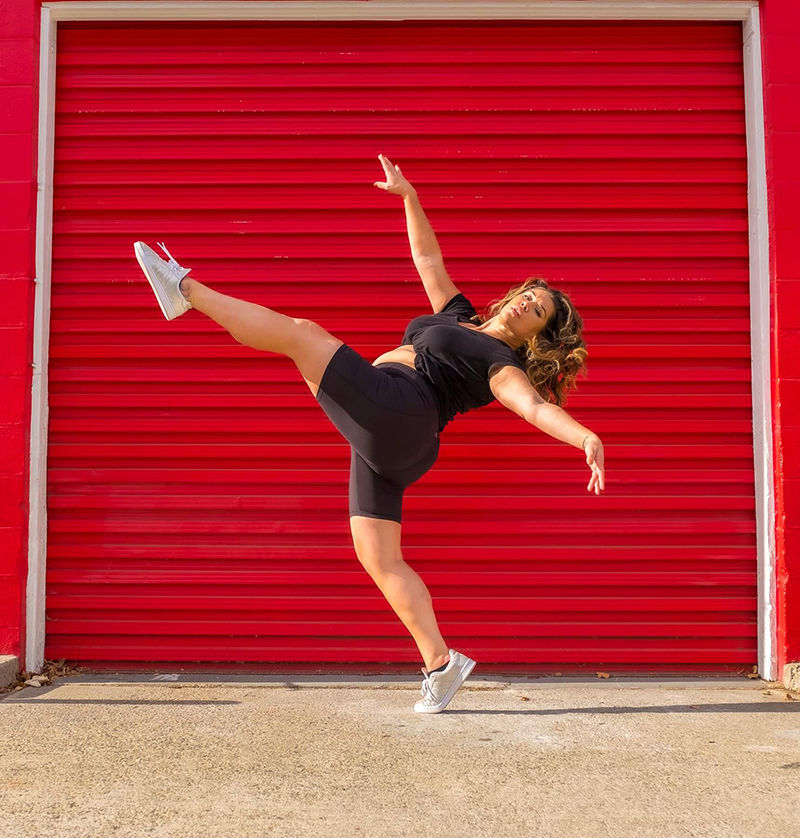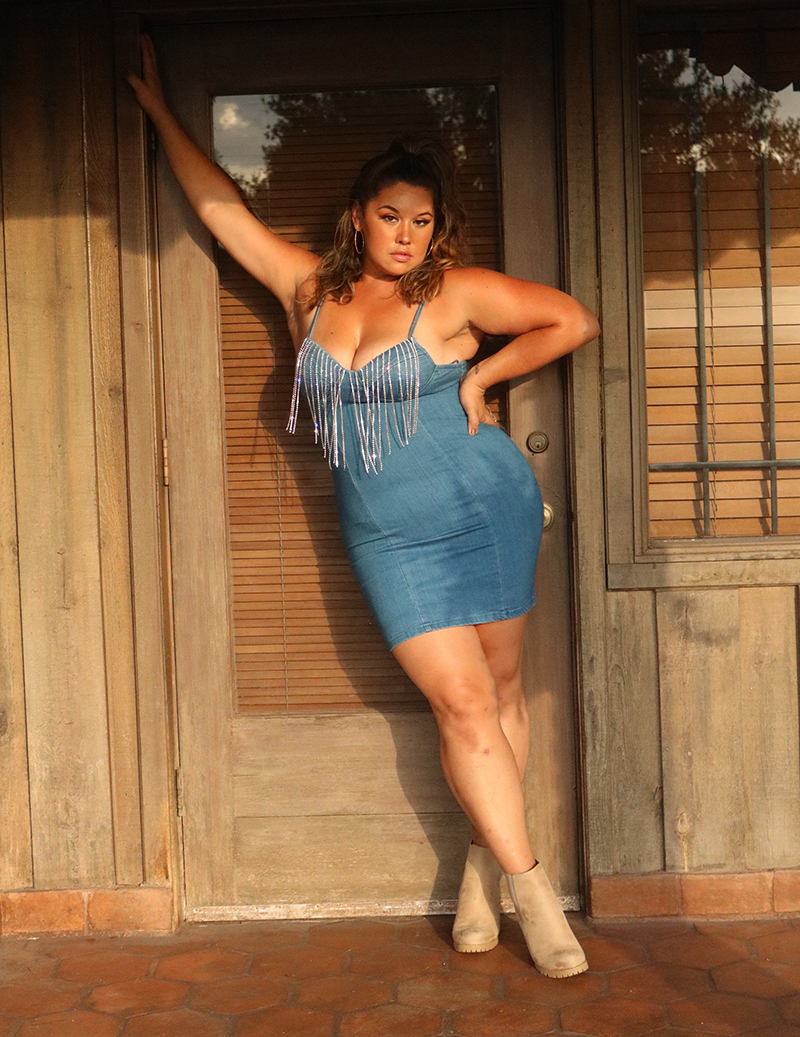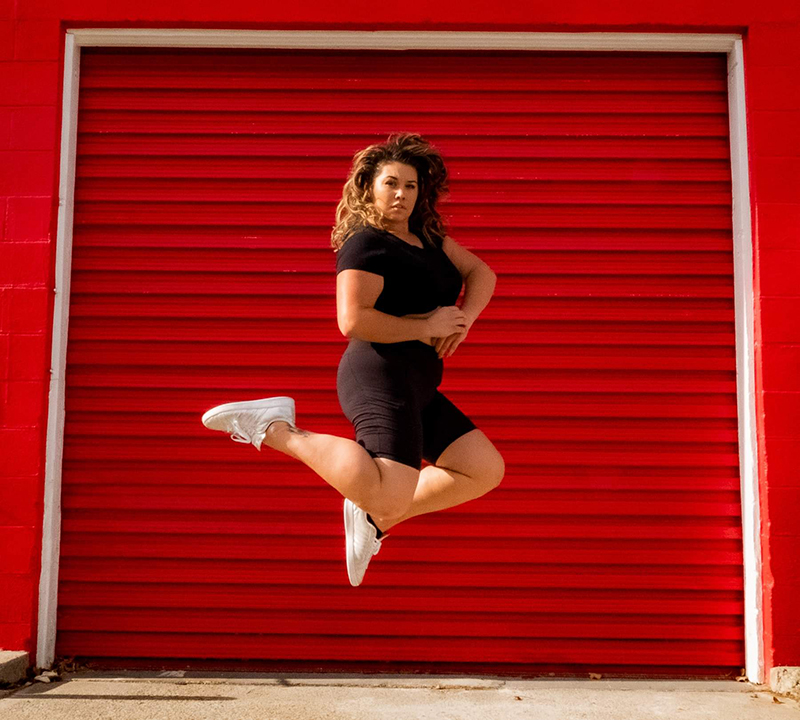Promoting Acceptance of All Sizes
An Interview with Amy Marie
BY EMMALY WIEDERHOLT
Amy Marie is a dancer and model based in the San Francisco Bay Area in California. She currently performs and teaches freelance, as well as works as a plus size model and plus size fit model. Here, she shares her experience forging a path for herself in both the dance and modeling worlds, and how she has come against prejudice for being a bigger person and for not being big enough.

Photo by Justin Schlesinger
~~
Can you tell me about your dance history and what shaped who you are as a dancer today?
I have been dancing nonconsecutively for 28 years. I started when I was three years old as a tiny ballerina. At a young age, I really got into it and wanted to stick with ballet. I did ballet for as long as I could until I folded under the pressure to lose weight and quit. I was mocked, mimicked, and ridiculed by my teachers and peers, by boys in class and in school. I grew up in Walnut Creek, CA, and the people who live there are predominantly thin. I was always the taller, wider, bigger body and stood out. After I quit, I still learned dances from music videos and sometimes choreographed for the cheerleading team but never felt like it was safe or acceptable for me to be a dancer. I never saw bigger bodies. There were no Lizzos. Missy Elliot was just coming on the scene. There was no one for me to look up to.
In college at Diablo Valley College and then at Cal State East Bay, I switched my major a few times, though it was always in the arts. When I started taking dance classes just for exercise, the professors started coming up to me and inviting me to be a part of projects as well as complimenting me on how I moved. It was weird to hear because I’d never heard that before. I danced with Kimberly Valmore’s Coterie Dance for a while. Kimberly is a professor at Diablo Valley College. But I was always the bigger and curvier dancer in every class or performance.
Post-graduation I tried to make my way as an independent performer and artist. I started my own company called AVID, which stood for Attentive Vulnerability in Dance. My goal was to focus on things that were vulnerable topics in order to bring visibility to difficult things to talk about, like bodies, gender, sexual orientation and preference, whatever I felt needed a voice in the moment. That company ended up dying out because of a lack of funding, momentum, and support.
I got in a toxic relationship that took me out of dance and I gained about 75 pounds. I was very unhappy and felt like my body couldn’t move. I didn’t understand all these issues that were coming up health-wise. When I had my heart broken and my boyfriend left me, I turned back to dance as a form of therapy. I went back to Cal State East Bay and started dancing with Eric Kupers. He welcomed me with open arms. I started making my way back into the community and danced with Antoine Hunter’s Urban Jazz Dance Company, a project by Dawn Holtan, and I joined Eric Kupers’ company Dandelion Dancetheater and Bandelion.
In 2019, I started teaching because I was tired of going to dance classes and not seeing teachers with bodies like mine. I’ve been trying to build a combination of classes that encourage all different levels and sizes of dancers to come move, learn about their bodies, and feel safe and welcomed. That was something I didn’t have for the majority of my dance life.
I’m teaching a lot now, even to kids. I take the opportunity to inspire, motivate, and speak about confidence and positivity. I teach eight-year-olds to teenagers at In Motion Dance Center in Martinez, CA, and then I teach independently, either by renting space or teaching outside due to COVID. Those classes vary between flex flow, contemporary, and heels. The heels class in particularly is about confidence and making modifications for people who are bigger in a way that doesn’t make them feel left out. Sometimes modifications aren’t exciting. That’s one area where I’m always challenging myself is by asking how I can make modifications that are enjoyable for bigger bodies.
You’re also a model. How did you get into modeling and how has your dance experience informed your modeling?
People kept telling me I was photogenic, so when I was 20 or 21, I went to a casting call. I can’t tell you what prompted that, as there were no notable bigger bodies who I knew of. The casting call was for a beauty billboard in the Bay Area. I got cast, and it went from there.
In addition to dance, I also studied theater throughout middle school, high school, and college. Theater and dance have helped me get in tune with being a vessel of emotion as well as with facial expressions. Throughout the years, I have come across people who ask me to model their items. A lot of being a dancer is shifting effortlessly between shapes. That’s also true of modeling, whether it’s holding an item or letting a garment move. I use my choreography to create amazing images.
I started working as an independent plus size model 13 years ago. That meant finding my own work, which often meant begging and pleading photographers to work with me. I would sometimes even offer to pay their rate, and they would say no one wants to see bodies like mine. The rejections over and over again were difficult to hear. As much as I want to say I pushed through, it was start and stop and I’d sometimes get momentum and then I couldn’t find anyone who wanted to work with me.
A couple years ago, I signed with MDT Agency to be a plus size fit model. A fit model is what the industry uses as a life size doll. Instead of using a mannequin, companies hire fit models to try on their garments and then give suggestions and feedback before the items are mass produced. No one sees my face or my body except for the creative team, but my feedback allows the team to make clothing work for bodies like mine. When I started working consistently as a plus size fit model, my confidence went up; my body is important and does the work for myself and others my size so that we can enjoy garments and have them fit us properly as opposed to being too tight or a sack of fabric. I realized my body is special, valuable, and important.
Going back to your heels class, how do you make it more welcoming and accessible for bigger dancers?
I call my heels class Head Over Heels. My goal is for everyone who takes my class to be head over heels in love with themselves and their bodies. A lot of people will take my class who have never danced in heels. Others are veterans in dance who take my class to work on how they feel in heels and how their body moves. We’ve been doing class outside this past year because of COVID, but before that we worked a lot with the mirror and spent time admiring how our bodies look and move. We bigger and curvier people have never been given the opportunity to admire our bodies. I’ve had people of any size come up to me crying at the end saying they didn’t know it was okay to look at themselves like this.
Often there’s a photoshoot option at the end of my classes. Students use everything they’ve learned in class – posing, posture, center of gravity, how to move the hips, shoulders, torso, or head, even choreography – and put themselves confidently in front of the camera. People have said so many positive things after taking just one class.
There are a lot of heels classes that have popped up as a commercial way of dancing. But my class is about more than learning choreography or technique. It’s about learning about your body and feeling comfortable and confident in it.

Photo by Tess Unsinn
What are some ways people talk about dancers in larger bodies that carry problematic implications or assumptions?
The phrases “for a big body, for a large body, for a fat body” are problematic even though I use them as well. We shouldn’t be categorized as separate. Sometimes we need modifications, sometimes we don’t. Social media has made it readily available to see all the bigger plus size curvy ballerinas. But now there are the dancers and then there are the fat dancers. That is my biggest problem; it’s now separate and not equal.
Another problem is that oftentimes plus size dance companies tell me I’m not plus size enough. I’m in this zone of being not thin, but also being not big enough to get support for being a plus size dancer, so it’s hard for me to make my mark because there is no lane. There are so many companies that only have fat dancers or non-fat dancers. I wish we could all get comfortable with the idea that a dancer is a body that moves, and those bodies can look differently.
This is especially true of ballet and modern dance companies and schools. The styles of dance that are more accepting are hip-hop, Latin dance, and competition ballroom. A lot of times I’ll go to a modern dance class and I’m one of the bigger bodies. I’m an XL, size 13-15, so in between very large and not large, and I’m still one of the biggest people in the class. That tells me there’s still work to be done. We need to make ourselves visible and get in class. We stay home because we feel unsafe or judged, or do things on our own, or join dance companies that are exclusively about fat acceptance. But then we’re separate.
Are attitudes toward dancers in larger bodies getting better or worse from your perspective?
I think attitudes are getting better because social media is bringing about a tiny bit more awareness. I’ve come across people all over the world who have similar stories as mine and don’t dance anymore. Maybe hearing my story has helped them go take a dance class. That’s why I continue to advocate and share my story, to inspire whomever I need to inspire.
What’s happening now is there’s a stereotype of what an acceptable fat body is. A popular person in commercial dance is Amanda Lacount; she is all over the LA scene and is popular on social media and music videos. Her body is apple-shaped where her limbs look fairly thin and then her torso is fatter. I see that other bigger dancers who are popular have the same body type. I wish there was visibility of other big bodies: bigger chested bodies, tall bigger bodies, bodies with bigger stomachs, thighs, or bottoms. Right now, there’s a little more acceptance of seeing plus size bodies, but only in a certain way. I’m hoping we can stop being narrowminded about our acceptance.
What terminology are you comfortable with?
I use terms that are familiar and easy for people to understand, like “plus size,” but I wish we could get to the point where I am just a model and a dancer, not a plus size model and dancer.
It doesn’t offend me when someone calls me fat, whether it’s negative or positive. I have fat on me, I’m a curvy body, I’m a plus size body. I’m not a skinny body. In that regard, words don’t bother me. But I know they bother other people. I’ve been reading about body positivity versus fat acceptance versus body neutrality. We’ve been trying to define all these words and movements we’ve created to empower, encourage, and uplift one another. Now there are unofficial committees that go around saying, “This term or that term is wrong,” when really it was all supposed to be about empowerment. For the longest time, there weren’t bigger bodies performing onstage.
But then there’s this disconnect because if your body changes and you happen to lose weight, you’re betraying the plus size and fat community. That is a conversation that is complicated but probably needs to start happening more. In 2017, I lost four people in my family, my dog of seven years died, and my relationship of seven years ended. It was difficult to find a reason to eat or live. I started reevaluating who I am, how I was living my life, and what’s important to me. I became vegan and was going to the gym out of survival mode. In a year, I lost 65 pounds. For a while, people were saying, “You’re not big anymore so you can’t advocate for us anymore.” But there’s still work to be done. I’m still bigger and struggling with trying to find support in all the right ways.
Like I said, it’s a conversation that needs to be had. It’s not about being judgmental or critical, but consuming bad food isn’t healthy for a body of any size. We need to be healthy so that we can keep dancing. I love dancing and modeling, and I can’t do those things if I feel lethargic and my joints hurt. However, whenever articles are written about me, I get criticized for promoting obesity. They don’t know what I eat or how often I exercise or what my conversations with my doctors are. It’s complicated.
What are some steps that professional and educational dance institutions can take to make their spaces more welcoming to dancers in bigger bodies?
I would love and prefer to see a variety of bodies being studied and addressed instead of just commercial bodies. I remember going to see ballet performers when I was young who would always be thin and have the same kind of look. I would change the curriculum to show many examples of who a dancer can be. It starts with the director, producer, or choreographer. We need the people at the top to help us show many different types of bodies. It’s going to involve more than just one person in a dance piece or one ad or one campaign. It has to be ongoing. For generations, we haven’t seen what we’re trying to see now, so we have a lot to undo.
Do you have an upcoming project or focus you’d like to share more about? What’s next for you?
I haven’t started it yet, but I want to create a piece about that in-between space for bodies that are too big but not big enough at the same time. I’m very active on social media creating and sending messaging about confidence at any size. The most recent project I’ve worked on is empowerment of women throughout the ages. As soon as that finishes, I would love to explore the too-big-but-not-big-enough idea. I do a lot of virtual launches, so maybe I can create something that starts that conversation and see where it goes.
Any other thoughts?
I’ve talked mainly about dance, but modeling is a big part of my life. Right now, I’m also in that in-between with modeling. I lose out on opportunities because I’m not big enough. It hasn’t stopped me, but I have to do mental gymnastics with myself: Should I purposefully try and get bigger so I can have more opportunities? At the end of the day, that would be such a false narrative. I want to be healthy.
I’m at a crossroads in a lot of different ways: I’m not completely commercial, but I’m not completely experimental; I’m not thin, but I’m not fat enough; I’m not old, but I’m not young anymore. I have toes in all these different identities.

Photo by Justin Schlesinger
~~
To learn more, visit amymariela.com.
